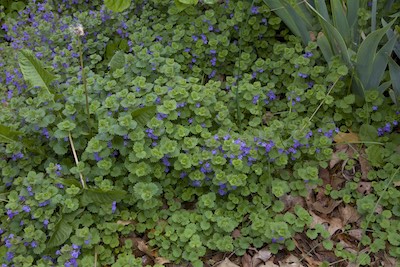How to Deal with Creeping Charlie
Most gardeners have strong opinions about creeping Charlie, the weed more formally known as Glechoma hederacea. Some love it, claiming creeping Charlie provides food for bees and a savory, minty smell. Others wage war against this weed as though their lives depended on its eradication.
Glechoma hederacea is an herbaceous groundcover perennial native to the United Kingdom, but it has grown in North America for almost 200 years, creeping throughout most of the United States and southern Canada. It spreads quickly via stolons, horizontal stems that root as they grow along the ground. The plant can easily regrow from tiny pieces of stem that break off when you try to pull it up, which is one of the reasons creeping Charlie is so difficult to remove.
When conditions are right, creeping Charlie effortlessly crowds out other plants. It grows best in shade to part shade and in moist, disturbed soils. Conditions that are ideal for creeping Charlie are usually not good for turfgrass, which helps creeping Charlie beat out the turf and become well established. Aside from infesting poorly managed lawns, creeping Charlie is also a common garden weed.

I’m currently experiencing a personal crossroads regarding creeping Charlie. Our small urban yard is surrounded by other yards, and these lawns and gardens are full of creeping Charlie. It’s impossible to police all of the borders, especially in the areas where my lawn is directly connected to the other lawns.
By the end of last fall, I realized that most of my front “lawn” was actually made up of creeping Charlie. I was briefly alarmed before also realizing that this “lawn” had been increasingly easy to care for all season, requiring little mowing and no watering whatsoever, while still remaining green enough that I hadn’t noticed the change. The weed also held up remarkably well to my dog’s high-energy sprinting, which destroys the grass. I started to wonder if it was an acceptable alternative to my sad, half-hearted attempts at growing grass.
Eradication vs. Tolerance
Before you come after me with your hoes and garden forks, consider that the Minnesota Department of Natural Resources does not categorize Glechoma hederacea as a threat to healthy native plant communities (although it is classified as an invasive plant). It isn’t on any of Minnesota’s noxious-weed lists. It doesn’t propagate much via seed, so it can’t spread as quickly as other invasive plants. As an early-flowering perennial, creeping Charlie can serve as a decent source of nectar for bees, although it doesn’t have pollen readily available for them.
Better Than Buckthorn
Consider, too, that creeping Charlie is often a lesser of two evils: its matlike cover can prevent other, nastier weeds from taking hold. As someone who has pulled a lot of weeds in a professional setting, I believe that creeping Charlie is one of the easier weeds to remove by hand, unless it gets completely entangled in a big patch of desirable groundcover. I would much rather encounter creeping Charlie than creeping bellflower, buckthorn, Canada thistle or quackgrass.
In most garden settings, repeated weeding will control small infestations. It will definitely take numerous attempts and will be easiest when the soil is slightly moist. For my gardens, I rely on other groundcover plants to outcompete the creeping Charlie, and then I regularly scout the garden borders for any rogue Charlies.
For gardeners who desire a well-manicured turfgrass lawn, this weed is a bigger problem than for those who find it contained within their gardens. Maintaining healthy dense turf that can crowd out weeds is the most important factor for keeping it out of your lawn. For small outbreaks, selective broadleaf herbicides such as 2,4-D, triclopyr or dicamba are good options for spot spraying. The University of Minnesota Extension recommends triclopyr as the most effective of these three. However, don’t spray these chemicals over tree root zones, as trees can absorb them and be injured.
For now, I’m practicing tolerance. I know that I can’t stop this plant from coming into my yard unless I wage a full-fledged war on all of the surrounding neighborhood yards. While I might try to improve my lawn’s overall health, which should discourage the creeping Charlie from being as vigorous as it is now, I also might just leave it alone as a low-maintenance substitute for my turfgrass.
This article by Laura Schwarz originally appeared in the May/June 2020 issue of Northern Gardener. Horticulturist and writer Laura Schwarz lives in Minneapolis, where she works in garden design, installation and maintenance.


Laura – I am proud of you! Tolerance of creeping Charlie is a wise choice. Our yard is full of it and I am happy to report that we spend less time mowing than any of our neighbors who fertilize often. Their grass grows more than ours does because of that expensive option. And our yard is a safe place for all creatures……people, critters, birds, butterflies and every breathing thing. Charlie thrives in our shady areas where nothing else grows. It just so happens that our dog is named Charlie, too!